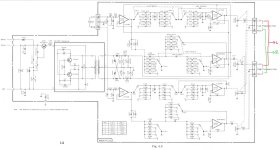I’ve been experimenting connecting the outputs of Nakamichi EC-200 electronic crossover in different way by tying low and high frequencies outputs together via Y-cables. The objective is to use it as a bass boosting that is splitting low and high frequencies apart for allowing level adjustments independently and merging them again before sending it to a single amplifier, see attached. The unit was inserted at tape minitor loop of the preamplifier section of the integrated amplifier. Normally, the high frequency level will be left at fully clockwise (maximum position). And the low frequency level will be used alternately from min to max positions for adjusting bass level. After experimenting, I found an issue that the signal cancelled (output decreased) against each other when the low level knob was set at fully clockwise (max) and fully anti-clockwise (min). But it summed at around mid-rotation. I’d like to ask if there’s a potential to modify the unit to completely perform as desired description earlier.
Attachments
The outputs of that unit should not be shorted together, that will overload the opamps inside it. Sum the outputs with some 1k resistors.
Crossovers may have 180 phase difference between low and high outputs.
Crossovers may have 180 phase difference between low and high outputs.
I’ve tried connecting them as assumed earlier, low and high frequency outputs directly meet each other, and it worked. It wasn’t harm anything.
However, I noticed there were cancellations on level adjustments at almost min and max positions—the level knobs had to be set at approximately between 9 am and 15 pm.
I wonder if that problem could be fixed by using an audio summing device such as a multiplexer, a mixer, etc. My friend suggested me to use a “summing amplifier”. Does anyone know what it is?
Nevertheless, I used to hear about the “mono to stereo audio converter”, is it usable?
However, I noticed there were cancellations on level adjustments at almost min and max positions—the level knobs had to be set at approximately between 9 am and 15 pm.
I wonder if that problem could be fixed by using an audio summing device such as a multiplexer, a mixer, etc. My friend suggested me to use a “summing amplifier”. Does anyone know what it is?
Nevertheless, I used to hear about the “mono to stereo audio converter”, is it usable?
I think it's best to set the high frequency level at the midpoint (12 o'clock), which will give the low frequencies a wider range of adjustment.Normally, the high frequency level will be left at fully clockwise (maximum position). And the low frequency level will be used alternately from min to max positions for adjusting bass level.
That is exactly what Mark is suggesting in post #2 with the 1K resistors. Personally I'd go a little higher but try it.I wonder if that problem could be fixed by using an audio summing device such as a multiplexer, a mixer, etc. My friend suggested me to use a “summing amplifier”.
This article covers that device slimply: www.electronicshub.org/summing-amplifier. Warning the site locked my browser up so tight I had to turn the computer off, but maybe you have more than 2 gb of memory to display all the dancing advertisements.I wonder if that problem could be fixed by using an audio summing device such as a multiplexer, a mixer, etc. My friend suggested me to use a “summing amplifier”. Does anyone know what it is?
You can buy that device commercially in a "mixer". I use a Peavey PV8. You will need some RCA plug cables. Plug low and high in different channels then set the 2 inputs to the output to your taste.
With the low & High knobs on the PV8 input channels, you will find you do not need the nakamichi EC-200.
A device cheaper than a PV8 on the used market is a graphic equalizer. I use a Peavey EQ-215 in live performance to eliminate howls from room feedback. Equalizers lack the microphone power and gain features of a mixer, also lack the effects loop , tape loop, and separate main & monitor outputs. Equalizers have been replaced by pros using cellphones with DSP. Disadvantage of DSP, the op system of cellphones updates twice yearly and the drivers for the DSP may not work in a year or two.
Last edited:
https://www.electronics-tutorials.ws/opamp/opamp_4.htmlMy friend suggested me to use a “summing amplifier”.
- Home
- Source & Line
- Analog Line Level
- Using electronic crossover as a bass booster

